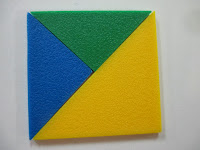Kim Yang, Sharon and I toured the Learning Gallery where we viewed, commented and pondered over Southeast Asian contemporary artworks of Eko Nugroho, Yuree Kensaku, Justin Lee, Zsa Zsa Zsu, Terra Bajraghosa among others. Walter the colossal bunny was there too.
Why were we there? Following in Greg Tang's footsteps to artfully build number sense, strengthen problem-solving skills and develop deep thinking skills in young children through contemporary artworks.
We'll be meeting again to think of creative ways to help young children sort, count, estimate and measure .....yup, it's our group assignment.
Found myself paying closer attention to the way Prof Yeap modelled how we should teach mathematics...by asking lots of questions:
"I wonder which container
can hold more water?
How can you tell?
Are you saying you can use
2 small triangles
to make a bigger square?
Are there other ways
to make this square?
Why not?
It's a surprise, isn't it? the more pieces you use,
the larger the square
is that true?
is that true?
Can someone explain
how you can make
a smaller square with
more pieces of triangles?
Problem 18: Make Squares (using tangrams)
Priscillia, Kim Yang and I formed these squares with different number of tangram pieces:
 |
| 2 pieces |
 |
3 pieces
|
|
4 pieces 5 pieces
|
7 pieces
We couldn't figure out how to use 6 pieces to create a square.
I wonder why?
Prof Yeap reminded us that
learning is not
knowing more
but tehinking more deeply.
|
Next, we traced these squares on a white piece of paper and began taking a closer look at the squares to answer these questions:
How many different sizes?
How many ways to create the square of one size?
How many pieces can you uese to create a bigger square?
Are there squares of other sizes?
Before we attempted to solve problem 19, we discovered that multiplication
has 4 meanings:
1. the equal groups (e.g. 6 groups of 4)
2. comparison (4 times as many girls) but not 4 times "more than"
3. area model (using square tiles e,g, 7 x4)
as compared with array model (rows of birds or soldiers)
4. combinations (counting the possible pairings that can be made between 2 or more sets)
5. rate (e.g. 3 km per hour
2 hr --> 6km (2x3)
3hr --> 9km (3x3)
(refer to pages 168-169 of textbook)
Problem 19: Making squares from triangles
Method 1
Cut out a triangle (in this case an isosceles right angle triangle = 90 degrees).
How do we know that the smaller angles are 45 degrees each?
Fold the two corners from the base to the top (right angle) (45 + 45 =90).
Method 2 (as suggested by Rowena our mathematician)
Tear off the three corners of the triangle and arrange them to form a straight line.
Does that make sense?
What is making sense?
It is making connections (connecting prior knowledge about 180 degrees on a straight line) to the present task.
Next, we were challenged to convert a triangle into a rectangle.
Method 1:
Similar to folding triangle into square (above).
Can you calculate the area of the rectangle if you know the lengths of two sides of the triangle (one is Bcm and the other is H cm)?
If you can, you have arrived at the formula for area of triangle:
1/2 base x height
Method 2 (as shared by Rowena)
Cut off the top portion of the triangle, rotate it and place it next to the bottom half to get a rectangle.
An important reminder:
Teachers need to apply Howard Gardner's Multiple Intelligence theory in their classrooms. The more we allow our students to use their five senses plus their interpersonal and intrapersonal intelligences, the better they can assimilate and accommodate new information (Jean Piaget's theory).
As Confucius said...
in other words ....
A fruitful evening indeed!














No comments:
Post a Comment